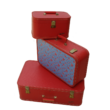Best Sleeping Bags: As outdoor enthusiasts, we know the importance of having the right gear for any adventure. One of the most crucial pieces of equipment for any camping trip is a high-quality sleeping bag. A sleeping bag not only keeps you warm and comfortable but also provides a barrier between you and the ground.
But with so many options on the market, how do you choose the best sleeping bag for your needs? In this guide, we’ll take a look at some of the top sleeping bags available and provide expert tips for selecting the perfect one.
What to Consider When Choosing the Best Sleeping Bag
Before we dive into the top picks, let’s take a look at some of the key factors to consider when choosing a sleeping bag.
- Consider the Temperature Rating: Make sure to choose a sleeping bag with a temperature rating that’s appropriate for the conditions you’ll be camping in. If you’re planning on camping in colder temperatures, look for a bag with a lower temperature rating. On the other hand, if you’re camping in warmer weather, you might be able to get away with a bag with a higher temperature rating.
- Think About Insulation Type: The type of insulation used in the sleeping bag is another important factor to consider. Down insulation is lightweight and compressible, making it a great option for backpackers. However, down can be more expensive and doesn’t perform as well in wet conditions. Synthetic insulation, on the other hand, is more affordable and performs better in wet conditions.
- Consider the Shape: Sleeping bags come in a variety of shapes, including rectangular, semi-rectangular, and mummy. Rectangular bags offer more room to move around but are less efficient at retaining warmth. Semi-rectangular bags are a good compromise between roominess and warmth retention. Mummy bags are more fitted and provide better warmth retention, but can feel constricting for some people.
- Check the Size and Weight: The size and weight of the sleeping bag are important factors to consider, especially if you plan on backpacking. Look for a bag that’s lightweight and compact, but still roomy enough for you to move around in. Keep in mind that a lighter sleeping bag may sacrifice some warmth or durability.
- Consider Durability: Make sure the sleeping bag is made of high-quality materials that can withstand wear and tear. Look for reinforced stitching and durable zippers. Keep in mind that a more durable sleeping bag may be heavier or more expensive.
20 Best Sleeping Bags
If you’re in the market for a new sleeping bag, there are plenty of options to choose from. To help you narrow down your search, we’ve compiled a list of the 20 best sleeping bags on the market today.
- NEMO Disco 15 Sleeping Bag
The NEMO Disco 15 Sleeping Bag is a popular choice among backpackers and campers. It features a unique spoon shape that provides plenty of room to move around and a temperature rating of 15°F. The bag is made with 650-fill-down insulation and has a waterproof and breathable foot box.
- Western Mountaineering UltraLite Sleeping Bag
The Western Mountaineering UltraLite Sleeping Bag is a lightweight and compressible option for backpackers. It’s made with 850-fill down insulation and has a temperature rating of 20°F. The bag is also water-resistant and features a full-length zipper for easy ventilation.
- Marmot Trestles Elite Eco 20 Sleeping Bag
The Marmot Trestles Elite Eco 20 Sleeping Bag is an eco-friendly option made with recycled materials. It has a temperature rating of 20°F and is made with synthetic insulation. The bag features a two-way zipper, a hood with an adjustable drawcord, and a roomy foot box.
- Therm-a-Rest Questar 20 Sleeping Bag
The Therm-a-Rest Questar 20 Sleeping Bag is a versatile option that’s great for backpacking and camping. It has a temperature rating of 20°F and is made with 650-fill down insulation. The bag features a foot box vent for easy temperature regulation, as well as a draft collar and draft tubes to keep cold air out.
- Kelty Cosmic 20 Sleeping Bag
The Kelty Cosmic 20 Sleeping Bag is a budget-friendly option that still provides great quality. It has a temperature rating of 20°F and is made with 600-fill down insulation. The bag features a draft collar and draft tube to keep cold air out, as well as a two-way zipper for easy ventilation.
- Big Agnes Lost Dog 15 Sleeping Bag
The Big Agnes Lost Dog 15 Sleeping Bag is a cozy and comfortable option for cold-weather camping. It has a temperature rating of 15°F and is made with synthetic insulation. The bag features a unique Flex Pad Sleeve that attaches to your sleeping pad for added warmth and comfort.
- The North Face Eco Trail Bed 20 Sleeping Bag
The North Face Eco Trail Bed 20 Sleeping Bag is another eco-friendly option made with recycled materials. It has a temperature rating of 20°F and is made with synthetic insulation. The bag features a wraparound zipper for easy ventilation and a roomy foot box.
- Sea to Summit Flame Fm0 Sleeping Bag
The Sea to Summit Flame Fm0 Sleeping Bag is a lightweight and compact option for backpackers. It has a temperature rating of 32°F and is made with 850-fill down insulation. The bag features a full-length zipper and a contoured hood for added warmth.
- Big Agnes Cabin Creek 15 Sleeping Bag
The Big Agnes Cabin Creek 15 Sleeping Bag is a spacious and comfortable option for car camping. It has a temperature rating of 15°F and is made with synthetic insulation. The bag features a sleeve that fits two sleeping pads for added comfort, as well as a built-in pillow pocket.
- REI Co-op Magma 15 Sleeping Bag
The REI Co-op Magma 15 Sleeping Bag is a top-rated option for backpackers and campers. It has a temperature rating of 15°F and is made with 850-fill down insulation. The bag features a unique diagonal baffle design that helps eliminate cold spots.
11. Mountain Hardwear Phantom 15 Sleeping Bag
The Mountain Hardwear Phantom 15 Sleeping Bag is a lightweight and compressible option for backpackers. It has a temperature rating of 15°F and is made with 800-fill down insulation. The bag features a contoured hood and a draft collar to keep cold air out.
12. Feathered Friends Swallow Nano 20 Sleeping Bag
The Feathered Friends Swallow Nano 20 Sleeping Bag is a high-quality option made with 950-fill down insulation. It has a temperature rating of 20°F and features a roomy foot box and a draft collar for added warmth.
13. NEMO Forte 20 Sleeping Bag
The NEMO Forte 20 Sleeping Bag is a versatile option that’s great for backpacking and camping. It has a temperature rating of 20°F and is made with synthetic insulation. The bag features a unique spoon shape that provides plenty of room to move around.
14. Sierra Designs Cloud 20 Sleeping Bag
The Sierra Designs Cloud 20 Sleeping Bag is a lightweight and compressible option for backpackers. It has a temperature rating of 20°F and is made with 800-fill down insulation. The bag features a draft collar and draft tubes to keep cold air out.
15. Big Agnes Anvil Horn 15 Sleeping Bag
The Big Agnes Anvil Horn 15 Sleeping Bag is a cozy and comfortable option for cold-weather camping. It has a temperature rating of 15°F and is made with 600-fill down insulation. The bag features a unique Flex Pad Sleeve that attaches to your sleeping pad for added warmth and comfort.
16. Kelty Cosmic 0 Sleeping Bag
The Kelty Cosmic 0 Sleeping Bag is a budget-friendly option that still provides great quality. It has a temperature rating of 0°F and is made with 600-fill down insulation. The bag features a two-way zipper and a draft collar to keep cold air out.
17. Rab Mythic 400 Sleeping Bag
The Rab Mythic 400 Sleeping Bag is a lightweight and compressible option for backpackers. It has a temperature rating of 21°F and is made with 900-fill down insulation. The bag features a contoured hood and a draft collar for added warmth.
18. The North Face Inferno -20 Sleeping Bag
The North Face Inferno -20 Sleeping Bag is a heavy-duty option for extreme cold weather camping. It has a temperature rating of -20°F and is made with synthetic insulation. The bag features a full-length zipper and a roomy foot box.
19. Therm-a-Rest Oberon 0 Sleeping Bag
The Therm-a-Rest Oberon 0 Sleeping Bag is a versatile option that’s great for backpacking and camping. It has a temperature rating of 0°F and is made with 800-fill down insulation. The bag features a draft collar and draft tubes to keep cold air out.
20. REI Co-op Trailbreak 20 Sleeping Bag
The REI Co-op Trailbreak 20 Sleeping Bag is a budget-friendly option that’s great for beginners. It has a temperature rating of 20°F and is made with synthetic insulation. The bag features a roomy foot box and a draft collar to keep cold air out.
Similar Articles
Frequently Asked Questions About Best Sleeping Bag
What is a sleeping bag?
A sleeping bag is a portable insulated covering that you can sleep inside while camping, backpacking, or traveling. It is designed to keep you warm and comfortable while you sleep outdoors.
What are the different types of sleeping bags?
There are several types of sleeping bags, including rectangular, mummy, and semi-rectangular. Rectangular sleeping bags are the most spacious and comfortable, while mummy bags are the warmest and most compact. Semi-rectangular bags offer a balance between comfort and warmth.
How do I choose the right sleeping bag for my needs?
When choosing a sleeping bag, consider factors such as temperature rating, insulation type, weight, and packability. Choose a bag with a temperature rating appropriate for the conditions you will be camping in, and select an insulation type that fits your needs and budget.
What is the difference between down and synthetic insulation?
Down insulation is made from the soft feathers of ducks or geese and is known for its lightweight and compressible properties. Synthetic insulation, on the other hand, is made from man-made fibers and is typically less expensive and more durable than down. Both types of insulation have their pros and cons, so choose the one that works best for your needs.
What is the ideal temperature rating for a sleeping bag?
The ideal temperature rating for a sleeping bag depends on the conditions you will be camping in. If you plan to camp in cold weather, choose a bag with a lower temperature rating, and if you will be camping in warmer weather, choose a bag with a higher rating.
Can I wash my sleeping bag?
Yes, you can wash your sleeping bag, but it’s important to follow the manufacturer’s instructions carefully. Use a mild detergent and avoid using bleach or fabric softeners. It’s also important to dry your sleeping bag properly, either by hanging it up or using a dryer in a low heat setting.
How do I store my sleeping bag?
To store your sleeping bag, first, make sure it is completely dry. Then, stuff it into its stuff sack or a large pillowcase, and store it in a cool, dry place. Avoid storing your sleeping bag in a compressed state for long periods of time, as this can damage the insulation.
Can I use a sleeping bag as a blanket?
Yes, you can use a sleeping bag as a blanket by unzipping it and laying it flat. However, keep in mind that a sleeping bag is designed to be used as a sleeping bag, and using it as a blanket may not provide the same level of warmth and comfort.
Can I use a sleeping bag in a tent or under the stars?
Yes, you can use a sleeping bag in a tent or under the stars. However, if you plan to sleep outside, make sure you have a waterproof ground cover and a suitable shelter to protect you from the elements.
How long will a sleeping bag last?
The lifespan of a sleeping bag depends on a variety of factors, including the quality of the materials, how often it is used, and how well it is cared for. With proper care, a high-quality sleeping bag can last for many years.
Can I use a sleeping bag liner to increase warmth?
Yes, a sleeping bag liner can add extra warmth to your sleeping bag, especially in colder conditions. They also add a layer of protection, keeping your sleeping bag cleaner and extending its lifespan.
Can I zip two sleeping bags together to make a double sleeping bag?
Yes, some sleeping bags are designed to be zipped together to create a double sleeping bag. Make sure to check with the manufacturer or retailer to ensure compatibility between the sleeping bags.
How do I know if a sleeping bag will fit me properly?
When choosing a sleeping bag, consider the dimensions of the bag, including its length, width, and shoulder and hip girth. You want to make sure the bag is long enough to cover your body from head to toe and wide enough to allow you to move comfortably inside.
How do I keep my sleeping bag dry in wet conditions?
To keep your sleeping bag dry in wet conditions, use a waterproof stuff sack or pack liner to protect it from moisture. You can also use a tent or tarp to create a dry shelter, and avoid setting up camp in areas that are prone to flooding or heavy rain.
Can I use a sleeping bag for other activities besides camping?
Yes, sleeping bags can be used for a variety of outdoor activities, including backpacking, hiking, and mountaineering. They can also be used for indoor activities like sleepovers and movie nights.
Can I use a sleeping bag without a sleeping pad?
While you can technically use a sleeping bag without a sleeping pad, it is not recommended. A sleeping pad provides insulation and cushioning, making your sleeping bag more comfortable and warm. It also protects your sleeping bag from the ground, preventing damage and prolonging its lifespan.
Can I use a sleeping bag in a hammock?
Yes, you can use a sleeping bag in a hammock. However, make sure to choose a sleeping bag with a suitable temperature rating and insulation type for the conditions you will be hammocking in.
Can I bring my sleeping bag to the plane?
Yes, you can bring your sleeping bag on a plane, but it must be checked as baggage. Make sure to check with your airline to ensure you comply with their specific regulations and restrictions.
What should I do if my sleeping bag gets wet?
If your sleeping bag gets wet, try to dry it out as soon as possible. Hang it up or lay it flat in a well-ventilated area and avoid direct sunlight. You can also use a dryer on a low heat setting, but avoid using high heat or leaving it in the dryer for too long.
How do I know when it’s time to replace my sleeping bag?
It’s time to replace your sleeping bag when it no longer provides adequate warmth, when the insulation is compressed or damaged, or when the fabric or zippers are worn or torn. A good rule of thumb is to replace your sleeping bag every 5-10 years, depending on usage and care.









